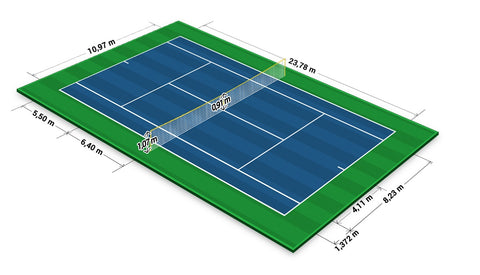What’s up with tennis scoring? Seriously.
Tennis scoring goes 15-30-40-deuce, advantage-in, deuce!? Sets to six games but you have to win by two, unless you get to six, when you play a tie-break!?
So how does tennis scoring work, and why does tennis scoring go 15-30-40? As other people have asked, why is tennis scoring so weird?
With this helpful overview from UTR Sports all about tennis scoring, you’ll never have to wonder those questions again.
Tennis scoring explained: the basics of the tennis scoring system
Tennis court dimensions
Before we start, let’s talk about the tennis court dimensions. Tennis is played on a 78-foot (23.78 meters) court. Singles matches are played without the doubles alleys, so that’s 27 feet wide. When doubles matches are contested, four people are on the court, and the court expands a bit to include the doubles alleys, so it’s 36 feet wide. On every court, the service line, the back line in the box where serves have to land, is 21 feet from the net.
When doubles matches are contested, four people are on the court, and the court expands a bit to include the doubles alleys, so it’s 36 feet wide. On every court, the service line, the back line in the box where serves have to land, is 21 feet from the net.

Now for the net. Every net should be three feet, six inches at the ends, also known as the posts, and three feet high (.91 meters) at the center.
Therefore, it’s always easier to hit the ball over the middle part of the net. Now that we know the dimensions and the true basics, let’s start playing tennis.
Tennis scoring explained: tennis game scoring
Tennis starts with points, which lead to games, which lead to sets, which lead to matches. Hence the term, game, set, match.
GAME. SET. MATCH.
— SportsCenter (@SportsCenter) July 14, 2019
Novak Djokovic outlasts Roger Federer in an epic five-set #WimbledonFinal 🏆 pic.twitter.com/4ZH2hrRfvt
Tennis Scoring: The start of the game, set, match
With one person serving and trying to serve the ball in the diagonal service box over the net, the game score is 0-0, or love-all.
If the server or serving team wins that point, it’s 15-0, or 15-love. If the opposing team or player wins, it’s 0-15, or love-15.
WATCH: Learn how to keep score in a game of tennis
The server always says their score first. To win a game, you have to win at least four points, and you have to win by two points.
Unlike other sports, such as volleyball years ago or pickleball in some places now in tennis, you don’t have to be serving to win a point.
Tennis scoring: points in games
To start: Love-all, or 0-0
One point: 15
Two points: 30
Three points: 40
Four points: Game
Tied at 40-40: deuce
Score after deuce if the server wins the deuce point: advantage-in
Score after deuce if the receiver wins the deuce point, advantage-out
You might hear someone say, 30-all, instead of 30-30. All, in this context, means everyone has the same score, i.e. you’re tied.
Why is tennis scoring so weird?
It's a good question: Why is tennis scoring is so weird? Why not have games start with one point, then two points, rather than 15, then 30?
No one knows for sure, and the internet has plenty of potential reasons. One popular theory is that the scoring was devised while using a clock, and that the three-syllable score of 45 eventually became too burdensome to say, hence the 40.
We could write pages on this topic, as others have here and here, but let’s talk about sets.

Tennis Scoring: Sets
Congrats! You’ve won a game of tennis. Only five more to go, at least, and then you’ve won a set.
Each set is played until at least six games, and, just like with points in games, you have to win by two in sets. For instance, you can’t win a set 6-5. You have to win 6-4 or 7-5, or 6-0, 6-1, and so on.
During sets, you change sides with your opponent after every odd game. So after the first, third, fifth, seventh, etc., games.
This helps even out the match, so one player isn’t playing with the wind at his or her back the entire match, or so one player isn’t serving with the sun in his or her face all afternoon as well.
Tennis Scoring: Set Tie-breaks
Tie-breaks come into play when both players or both doubles teams have won six games in the same set. Then you play a tie-break to seven points and, yes, you have to win by two.
Tie-breaks can go on forever, or until one team or player wins by two. The longest tie-break in ATP Tour history came in 2022, when American Reilly Opelka outlasted countryman John Isner in a 46-point tie-break (24-22).
The longest set tie-break in WTA history came in the last millennium, at the 1999 Madrid Open. Emmanuelle Gagliardi beat Tara Snyder 6–7(19–21), 6–1, 6–1 in the second round. The 40-point first-set tie-break remains the longest set tie-break in WTA history.
In a tie-break, the first team or player serves once from the deuce side, and then each team or player serves twice until the tie-break ends.
Tennis scoring: How many sets to win a match?
In recreational tennis, matches are typically best of three sets, or commonly known as best of three.
Often, including in UTR Sports Tennis Flex Leagues, in lieu of a third set, a 10-point match tie-break will be contested. In that match tie-break, the player has to win by two, and you change sides after every six points.
There are other variations to traditional tennis scoring, such as 8-game pro sets (for both singles and doubles) and single 6-game sets (for singles). In an 8-game pro set, players compete first to 8 games, win by two, with a tiebreak to 7 points played at 7-all or 8-all. UTR Sports allows for these two modified formats to count towards Verified UTR Ratings.
On the ATP Tour, the men’s professional tennis tour, where Novak Djokovic has won dozens of singles titles, singles matches are best of three sets.
On the WTA Tour, the women’s professional tennis tour, where Coco Gauff competes, singles matches are also best of three sets.
At the four major championships, also known as the Grand Slams – Australian Open, French Open, Wimbledon, and the US Open – women’s singles matches are best of three sets, and men’s singles matches are best of five sets, like the classic 2008 Wimbledon final between Rafael Nadal and Roger Federer.
Tennis scoring: Match Tie-breaks
In 2022, the four major championships agreed that if a men’s or women’s match reached the score of 6-6 in the final set, the match would end with a 10-point match tie-break.
Earlier this year, Anna Blinkova won the longest tie-break – set or match – in Grand Slam history, when she beat 2022 Wimbledon champion Elena Rybakina 6-4, 4-6, 7-6(20) in the second round.
ANNA. BLINKOVA.
— #AusOpen (@AustralianOpen) January 18, 2024
The moment Anna prevailed in a match etched into Grand Slam history.#AusOpen • #AO2024 • @wwos • @espn • @eurosport • @wowowtennis pic.twitter.com/JTUTc9YR9p
That 42-point tie-break surpassed the previous record, a 38-point match tie-break recorded at 2023 Wimbledon between Lesia Tsurenko and Ana Bogdan and a 38-point set tie-break played at the 2007 Australian Open between Andy Roddick and Jo-Wilfried Tsonga.
Now that you're an expert in tennis scoring, get on the court?
Get started by joining UTR Sports, the largest tennis and pickleball community in the world! Click here to get started.
Already have a UTR Rating? Play in a UTR Sports Flex League near you.
Tennis scoring: Read and watch more below
Wikipedia: Tennis scoring system
Wilson: How to keep score in tennis
Watch more on tennis scoring
Tennis Scoring FAQ's
What is tennis scoring?
A point-based system where game scores progress 0 (love), 15, 30, 40, then “game.” If both players reach 40, it’s “deuce,” followed by “advantage” and then game.
Why does tennis scoring go 15-30-40 instead of 1-2-3?
The origin is unclear, but the leading theory ties back to using a clock face for scoring—45 eventually shortened to 40 for ease of call.
How do you win a game in tennis?
You must win at least four points and lead by two. Points go love, 15, 30, 40, then “game.”
How many games make a set in tennis?
A set is won by the first player to six games, with at least a two-game margin. At 6-6, most formats use a seven-point tiebreak.
What is a tiebreak in tennis?
A mini-game played at 6-6 to seven points (win by two), with players alternating serves. It determines the set winner without endless games.
What does “deuce” mean in tennis scoring?
“Deuce” is any 40-40 tie. From deuce, a player must win two consecutive points—first gaining “advantage,” then “game.”
Tennis Scoring Glossary
A quick reference for the jargon that trips up new fans and players alike:
- Love: Zero points or games.
- Deuce: 40-40 in a game; you must win two in a row from here.
- Advantage-In/Out: “Ad-in” means the server has the edge after deuce; “ad-out” means the receiver does.
- Game, Set, Match: Four points (win by two) = game. Six games (win by two or tiebreak) = set. Best-of-(3 or 5) sets = match.
- Tiebreak: Mini-game (usually to 7, win by two) played at 6-6 in games to decide the set.
- No-Ad: Game decided by a single deuce point.
- Pro Set: One extended set to 8 games, with tiebreak at 7-7.
How to Keep and Announce Tennis Scores: Step-by-Step Guide
1. Start at Love–All
Both players begin at 0 points (“love–love”). The server always calls out the score first.
2. Track Points Within a Game
Point 1 → 15, Point 2 → 30, Point 3 → 40. If you win four points with a two-point margin (e.g. 40–15 ➔ next point wins), you take the game.
3. Handle Deuce and Advantage
At 40–40 you call “deuce.” Next point won by the server is “advantage in” (server edge), by the receiver is “advantage out.” From advantage you must win the following point too to close out the game; otherwise you revert to deuce.
4. Announce Games to Sets
After each game, update the game count. If the receiver won the game, say “one–love” (receiver one, server zero), but call it as “one–zero.” Example sequence: “Game, 2–1” means the server has 2 games, the opponent 1.
5. Track Sets
First to 6 games with a two-game margin wins the set (e.g. 6–3 or 7–5). Call it “Set, 6–3." At 6–6, play a tiebreak (see next section) instead of games to settle the set quickly.
6. Play the Tiebreak
Announce “Tiebreak to 7 (win by 2).” Server serves one point from the deuce side, then players alternate two serves each. Call the tiebreak score point-by-point (“Four–two,” etc.). The player who reaches 7+ first with a two-point lead wins the set 7–6.
7. Finish the Match
Most matches are best-of-three sets. Announce “Match” once the final set is won. Scoreline example: “6–4, 3–6, 7–6(7)” indicates a three-set match with a 7–6 tiebreak ending 7–4 in points.
By following these steps, you’ll be able to score, announce, and keep perfect track of every game, set, and match—no mysterious math required.






